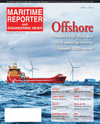
Page 38: of Maritime Reporter Magazine (April 2012)
Offshore Deepwater Annual
Read this page in Pdf, Flash or Html5 edition of April 2012 Maritime Reporter Magazine
34Maritime Reporter & Engineering News The merchant fleet of ships andtugs flying the Dutch flag to-taled 974 vessels on December 31, 2010: a further 800 vessels under other flags are managed by Dutchshipowners. The number of merchant ships in 2010 is higher than in 2009, but the total gross tonnage has decreased dueto a number of large ships having flagged out.According to the Royal Association of Netherlands Shipowners (KNVR), todays maritime industry is alive and healthy with many interesting develop- ments. New markets are evolving from the rise in offshore wind farms, the sur- veying, building and maintenance of them is a fast growing sector requiring specialist vessels and manpower. There is increasing interest in CO2 capture andstorage below the sea floor in obsolescent oil and gas wells. The use of LNG as a future fuel is also creating opportunitiesin the equipment, storage and distribution of the fuel. There are a number of im- portant issues facing the industry in the forthcoming years regarding require- ments and regulations: ?Targets to cut carbon emissions have been outlined as a long term goal. ?The imminent reduction of the sul- fur content of maritime fuels inEmission Control Areas (ECA). ?A reduction in underwater noise. ?The implementation of the Ballast Water Management convention. ?Meeting the new standards of NOx Emission Control Areas. Around 60% of the Dutch fleet is in-volved in short sea shipping between Eu- ropean countries and neighboringcountries such as Russia. Short sea ship-ping, accounts for 40% of the total goodstransported within Europes member states, and boasts significantly lower car- bon emissions than road transport.The International Maritime Organiza- tion (IMO) resolution declaring the BalticSea, the North Sea and the English Chan-nel as an ECA (Emission Control Areas) is due to come into force on January 1,2015. It will require the sulfur content offuel to drop from 0.5% to 0.1%. There is growing opposition to this early introduction. Present estimationsare that this will increase costs to theshort sea fleet by 70 to 80 percent. The industry has appealed to the EuropeanUnion EU in Brussels for more time andan investigation to prove that the cost will deliver the anticipated benefits. There is a real danger that soaring transport costs bysea will force goods off ships and onto the roads. The political expression is re- verse modal shift?! This would produce a net adverse effect on the environment ? a situation that would be very contrary to the aims of Brussels. Ship OperatorsThere are many Dutch sea and inland shipowners, the following is an overview of the activities of some of them. The shipping line Anthony Veder was established in 1937, is based in the Portof Rotterdam and is one of the few tanker owners totally dedicated to the transport of the liquefied gases. Their fleet covers specialist vessels for the transport of liq- uefied petroleum gas (LPG), liquefied natural gas (LNG), petrochemicals and Carbon Dioxide (CO2). Veder was the The Dutch Maritime Industry The broad base of the Netherlands maritime industry operating internationally with a highpercentage of export orders has weathered the financial storms of2008/9 with little or nodamage. The maritimeindustry as a whole pro- vides employment in theNetherlands for around 190,000 persons andwith a turnover of $24.7billion p.a., contributesapproximately 3% to the gross national product. By Keith Henderson(Image credit: Dockside) Docksides new Super Vessel, Dockwise Vanguard presently under construction at HHI shipyard in Korea is due for com- pletion in the latter part of 2012. It will have a capacity of more than 110,000 metric tons, and deck size of 900 x 230 ft (275 x 70 m).

 37
37

 39
39
